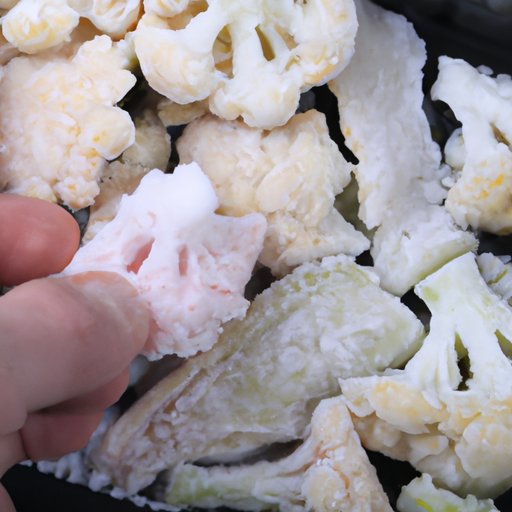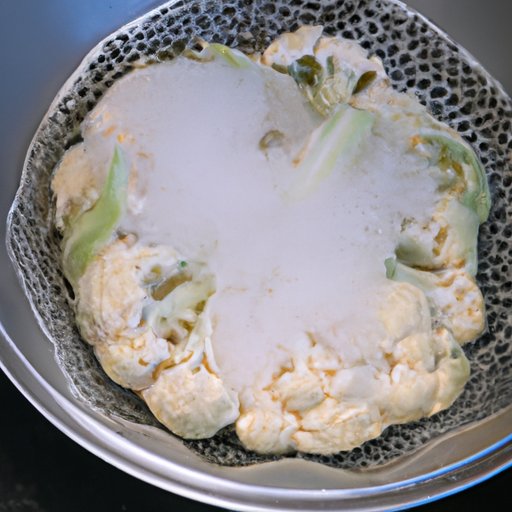I. Introduction
Cauliflower is a staple in many diets due to its nutritional value and versatility in recipes. However, it can be challenging to keep it fresh for an extended period, and often, it can be tempting to throw out the excess. But did you know that you can freeze cauliflower to preserve its quality? This article will walk you through the process of freezing cauliflower, its nutritional benefits, and recipes to try out.
II. Step-by-step guide for freezing cauliflower
Before freezing cauliflower, it’s essential to prep it correctly. Cut the cauliflower into smaller florets and remove the stems and leaves. Rinse the florets in cold water to remove any dirt or debris.
A. Prepping cauliflower for freezing
Blot the florets dry with a paper towel or a kitchen towel to remove any excess moisture. Any moisture left on the florets can cause freezer burn or frost to accumulate. Once dry, you can proceed to the next step.
B. Choosing between raw and blanched freezing methods
There are two methods of freezing cauliflower: raw and blanched. Raw freezing is a simple process that requires no blanching, but it’s less effective than blanching, as it tends to produce a softer cauliflower after thawing.
Blanching involves dipping the cauliflower in boiling water for a set amount of time, then transferring it to a bowl of ice-cold water to stop the cooking process. Blanching helps to preserve the texture, flavor and retain the cauliflower’s nutritional content after thawing.
C. Tips for proper storage and labeling
Once you have chosen your preferred method, it’s essential to use airtight containers or freezer bags to store the cauliflower. Make sure to remove as much air as possible to prevent freezer burn or ice crystals from forming on the cauliflower. Label each container or bag with the date of freezing and the content name to keep track of what’s in your freezer.
III. Comparing different freezing methods
There are various blanching methods to choose from, each with unique benefits and disadvantages.
A. Raw freezing method
As stated earlier, raw freezing is an option for those who don’t have time to blanch their cauliflower. However, it tends to produce a softer cauliflower after thawing. It’s essential to freeze the cauliflower on a baking sheet, so it doesn’t stick together when frozen in a container afterward.
B. Blanching freezing method
The most common blanching method requires a pot of boiling water, a bowl of ice-cold water, and a slotted spoon. Boil the cauliflower for about three minutes, then transfer it using a slotted spoon to a bowl of cold water for about three minutes to stop the cooking process.
C. Water blanching freezing method
The water blanching method is similar to the blanching method, but the cauliflower is immersed in cold water instead of ice-cold water. You can use this method if you don’t have ice on hand.
D. Steam blanching freezing method
The steam blanching method requires a steaming basket and a pot with a lid. Steam the cauliflower for about five minutes until it’s tender, then transfer it to a bowl of ice-cold water for three minutes to stop the cooking process.
E. Comparing freezing methods and their effectiveness for cauliflower
Blanching is the preferred method of freezing cauliflower because it preserves the texture, flavor, and nutritional value. However, if you don’t have time to blanch, raw freezing is an option but may produce a softer cauliflower after thawing.
IV. Nutritional benefits of cauliflower and freezing effects
Cauliflower is a low-calorie vegetable that’s high in fiber, vitamins, and minerals. It’s an excellent source of vitamin C, vitamin K, folate, and potassium. Freezing cauliflower can cause a slight decline in nutritional value, but blanching before freezing can help retain most of its nutrients.
A. Nutritional value of cauliflower
Cauliflower is a nutrient-dense vegetable that can enhance your diet with numerous health benefits. It’s an excellent source of vitamin C, vitamin K, and fiber, which can help improve digestion and maintain a healthy immune system.
The vegetable also contains choline, which helps with learning and memory, and it’s essential during pregnancy for fetal brain development.
B. Freezing effects on cauliflower nutritional content
Freezing cauliflower can cause a slight decline in its nutritional value. However, blanching before freezing can help retain most of the vegetable’s nutritional content.
Blanching destroys the enzymes that cause the vegetable to spoil, and it also seeps the nutrients inside the cauliflower. While freezing can cause the cauliflower to lose some nutritional value, it’s still a good source of vitamins and minerals to include in your diet.
C. How to maintain cauliflower’s nutritional value during freezing
To maintain cauliflower’s nutritional value during freezing, it’s essential to blanch the vegetable before freezing. Blanching helps to slow enzymes’ action that can cause the cauliflower to spoil and preserve the vegetable’s nutrients.
V. Recipe roundup featuring frozen cauliflower dishes
If you’re unsure how to use frozen cauliflower, there are numerous recipes that you can make using the vegetable. Here are a few recipes to try out:
A. Roasted cauliflower
Roasted cauliflower is a simple and delicious recipe that can be made using frozen or fresh cauliflower. Toss the cauliflower in olive oil, salt, and pepper, then roast in the oven until crispy and golden brown.
B. Cauliflower soup
Cauliflower soup is a hearty and nutritious meal that’s easy to make using frozen cauliflower. Saute onions and garlic in a pot, then add the cauliflower, broth, and herbs. Simmer until the cauliflower is tender, then blend until it’s smooth.
C. Cauliflower rice
Cauliflower rice is a popular low-carb alternative to traditional rice. Grate the cauliflower or pulse it in a food processor until it resembles rice grains. Sautee it in a pan with some oil and seasonings until tender.
D. Cauliflower pizza crust
Cauliflower pizza crust is a gluten-free alternative to traditional pizza crust. Mix the cauliflower rice with some cheese, herbs, and an egg, then shape it into a crust. Bake in the oven until crispy, then add your favorite toppings.
E. Other recipes featuring frozen cauliflower as the main ingredient
Other recipes featuring frozen cauliflower include cauliflower au gratin, cauliflower stir-fry, and cauliflower nuggets. These are all easy recipes that you can make using frozen cauliflower that are perfect for a quick and healthy meal.
VI. Common mistakes when freezing cauliflower and how to avoid them
Freezing cauliflower is relatively simple, but there are common mistakes that people make that can affect the quality of the cauliflower. Here are a few mistakes to avoid:
A. Not properly cleaning and prepping cauliflower
Make sure to clean and prep the cauliflower adequately before freezing to prevent dirt and debris from affecting the quality of the vegetable.
B. Not using proper storage techniques
Use airtight containers or freezer bags to store the cauliflower and remove any excess air to prevent freezer burn or ice crystals from forming.
C. Freezing cauliflower in large chunks
Freezing cauliflower in large chunks can cause the vegetable to lose its texture when thawed. Cut the cauliflower into small florets before freezing.
D. Avoiding common mistakes to successfully freeze cauliflower
Follow the step-by-step guide mentioned earlier, and avoid the common mistakes mentioned above to ensure that your frozen cauliflower stays fresh and flavorful for an extended period.

VII. Health risks associated with improperly handled frozen cauliflower
Improperly handled frozen cauliflower can cause foodborne illness. Here are a few potential health risks and their symptoms:
A. Foodborne illness risks
Foodborne illnesses associated with cauliflower include E. coli and salmonella. These can cause symptoms such as vomiting, nausea, abdominal pain, and diarrhea.
B. Symptoms of foodborne illness
The symptoms of foodborne illness can vary from person to person, but they typically include vomiting, nausea, fever, stomach cramps, and diarrhea. In severe cases, it can lead to hospitalization and even death.
C. Preventative measures for avoiding foodborne illness
Preventative measures for avoiding foodborne illness include washing your hands thoroughly with soap and hot water before handling food, cooking food to the recommended minimum internal temperature, and storing food at the proper temperature. When handling frozen cauliflower, make sure to follow proper thawing techniques and avoid cross-contamination with other foods.
VIII. The importance of blanching cauliflower before freezing
A. Explanation of blanching process
Blanching is a cooking process that involves boiling vegetables for a set amount of time, then transferring them to a bowl of ice-cold water to stop the cooking process. Blanching helps to preserve the color, texture, and flavor of vegetables while also extending their shelf life.
B. Benefits of blanching cauliflower before freezing
Blanching cauliflower before freezing helps to preserve the vegetable’s nutritional content, texture, and flavor. It destroys the enzymes that cause the cauliflower to spoil, and it also helps to retain most of the vegetable’s nutrients.
C. Comparing blanched versus non-blanched cauliflower
Cauliflower that has been blanched before freezing tends to retain its texture and taste better than non-blanched cauliflower, which can produce a softer vegetable after thawing. Blanched cauliflower also retains most of its nutritional content and is a better option for preserving cauliflower’s quality for an extended period.
IX. Conclusion
Freezing cauliflower is an excellent way to preserve the vegetable’s quality and extend its shelf life. Blanching before freezing is the most effective method for ensuring that the cauliflower retains its nutritional content, texture, and flavor. Making sure to follow proper thawing techniques and avoiding common mistakes will ensure that your frozen cauliflower stays fresh and flavorful.
So, the next time you have leftover cauliflower, don’t throw it away. Freeze it and use it in your favorite recipes.
Final thoughts on successfully freezing cauliflower.
Freezing cauliflower is an easy and convenient way to keep the vegetable fresh for an extended period. It’s essential to follow proper freezing techniques, including preparation, choosing between the raw and blanched freezing methods, and proper storage and labeling. Blanching is the preferred method for preserving cauliflower’s quality after thawing, and it also helps to retain most of the vegetable’s nutritional content. To avoid the risks associated with improperly handled frozen cauliflower, make sure to follow proper thawing techniques and avoid cross-contamination with other foods.
